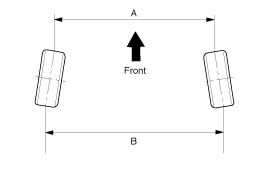Kia Soul EV: Tires/Wheels / Alignment Repair procedures
Kia Soul EV (PS EV) 2015-2020 Service Manual / Suspension System / Tires/Wheels / Alignment Repair procedures
| Front wheel alignment |
When using a commercially available computerized wheel
alignment equipment to inspect the front wheel alignment, always
position the vehicle on a level surface with the front wheels facing
straight ahead.
Prior to wheel alignment, steering column is approximately in tilt mid position. |
Toe

B - A > 0: Toe in (+)
B - A < 0: Toe out (-) |
Toe adjustment
| 1. |
Loosen the tie rod end lock nut. |
| 2. |
Remove the bellows clip to prevent the bellows from being twisted. |
| 3. |
Adjust the toe by screwing or unscrewing the tie rod. Toe
adjustment should be made by turning the right and left tie rods by the
same amount.
|
| 4. |
When completing the toe adjustment, install the bellows clip and tighten the tie rod end lock nut to specified torque.
|
Camber and Caster
Camber and Caster are pre-set at the factory, so they do not
need to be adjusted. If the camber and caster are not within the
standard value, replace or repair the damaged parts and then inspect
again.
Camber angle : -0.5° ± 0.5° |
Caster angle : 5.1.° ± 0.5° |
| Rear wheel alignment |
When using a commercially available computerized wheel
alignment equipment to inspect the rear wheel alignment, always position
the vehicle on a level surface.
Prior to inspection, make sure that the rear suspension
system is in normal operating condition and that the tires are inflated
to the specified pressure. |
Toe

B - A > 0: Toe in (+)
B - A < 0: Toe out (-) |
Toe is pre-set at the factory, so it does not need to be
adjusted. If the toe is not within the standard value, replace or repair
the damaged parts and then inspect again.
Toe-inTotal : 0.3° (+0.5° / -0.3°)
Individual : 0.15° (+0.25° / -0.15°) |
Camber
Camber is pre-set at the factory, so it does not need to be
adjusted. If the camber is not within the standard value, replace or
repair the damaged parts and then inspect again.
Camber : -1.5° ± 0.5° |
 Wheel Repair procedures
Wheel Repair procedures
Hub nut tightening sequence
Tighten the hub nuts as follows.
Tightening torque:
88.3 ~ 107.9N.m (9.0 ~ 11.0kgf.m, 65.1 ~ 79.6lb-ft)
When using an impact gun, fin ...
Other information:
Kia Soul EV (PS EV) 2015-2020 Service Manual: Rheostat Repair procedures
Inspection 1. Disconnect the negative (-) battery terminal. 2. Remove the crash pad lower panel. (Refer to Body - "Crash Pad Lower Panel") 3. Remove the lower crash pad switch assembly (A) by pushing it. 4. Disconnect the connectors (A) from the lower crash pad switch assembly. 5 ...
Kia Soul EV (PS EV) 2015-2020 Service Manual: Description and Operation
Description The Electro Chromatic inside rear view Mirror (ECM) is intended to dim the reflecting light in the rear view mirror. The forward facing sensor detects the brightness of the surroundings while the rearward looking sensor detects the intensity of the light from the rear. The int ...
Copyright © www.ksoulev.com 2020-2025




